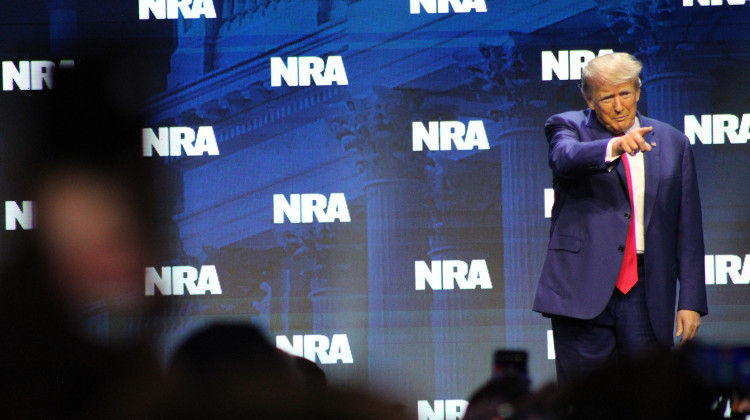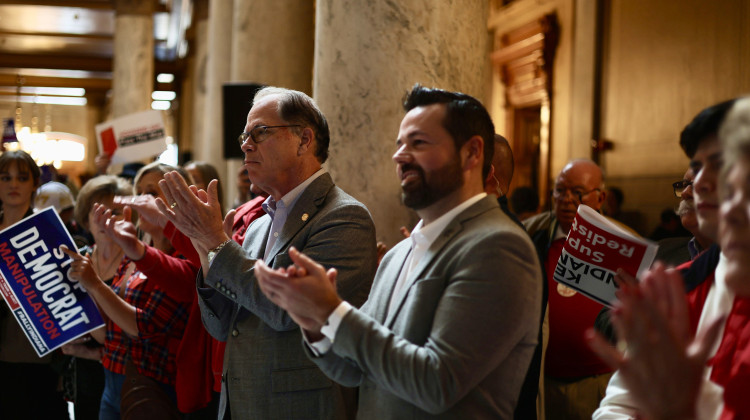
With the presidential election just around the corner many are asking what a second Trump term might mean for healthcare - and in particular, Medicaid
Ben Thorp / WFYIA big question for many people on Election Day will be how a new president could impact health care — particularly Medicaid, the public health insurance program for low-income adults.
Much has been made of Project 2025, a nearly 1,000-page blueprint for if former President Donald Trump were to win the upcoming election. It’s authored by the Heritage Foundation, a conservative think tank.
Democrats have worked hard to attach the plan to Trump’s campaign, while Trump himself has said he has no connection to the plan.
Lizzy McGrevy, Side Effects Public Media’s community engagement specialist, sat down with health reporter Ben Thorp to talk about what a new Trump administration might mean for Medicaid.
This transcript has been edited for length and clarity.
Lizzy McGrevy: So Ben, start by talking about what Project 2025 might tell us about how a new Trump administration might handle Medicaid.
Ben Thorp: So, Project 2025 is a huge plan that has eaten up a lot of political discourse and contains a range of conservative wish list items –– everything from abortion to immigration to Medicaid.
Trump himself has said he has no connection to the plan as you mentioned, and I think it’s good to mention that the ability of a Trump administration to pass many of these policies will also depend on the makeup of Congress after the election.
I also think it’s worth taking a step back to offer some history here. The 2010 Affordable Care Act expanded Medicaid to non-disabled adults under 65 who make up to 138% of the federal poverty level. To incentivize states to adopt the expansion, the federal government agreed to match states for 90% of the cost of the services to this new group.
Project 2025 talks about reforming financing for Medicaid in vague terms, calling for a more “balanced or blended” matching rate and the use of things like block grants, which essentially “cap” how much money can come to a state for Medicaid.
Experts I spoke with say that kind of language is something that essentially amounts to a cut, either to services or to the number of people who will ultimately be covered.
McGrevy: Well Ben, I’ve heard about cuts like these before. Correct me if I’m wrong, wasn’t the Repeal and Replace movement led by House Speaker Paul Ryan back in 2017 aimed at doing something similar?
Thorp: You’re exactly right Lizzy, a lot of this is not new.
Edwin Park is a researcher at Georgetown University McCourt School of Public Policy. He told me that efforts to cut Medicaid have been around for a long time and show up in a number of conservative plans, not just Project 2025.
“This proposal in Project 2025 is no different than what's commonly included in leading Republican conservative health plans,” he said. “[The cuts go] all the way back to Paul Ryan's budget plans, efforts to block grant, all the way back to Ronald Reagan In 1981, Newt Gingrich in 1995, and so forth.”
McGrevy: Ben, maybe it’s worth asking why so many conservative plans are aimed at reducing Medicaid spending.
Thorp: Well, it’s worth understanding that Medicaid, Medicare, and Social Security spending make up roughly half of the federal budget. So if you’re looking for places to cut it’s obviously up there.
Trump has pledged not to make cuts to either Medicare or Social Security but has made no mention of Medicaid so far.
I spoke with Brian Blase, a former Trump advisor and president of the conservative Paragon Health Institute. The institute recently released its own plan, which includes more explicit steps to phase down federal matching rates for Medicaid spending.
Conservatives like Blase say those drawdowns are necessary, because of a growing federal deficit and because of a perceived abuse of Medicaid funding models.
“My view is that Medicaid, you know, it's a program for low-income Americans, it's a welfare program. It should not be a cash cow for the healthcare industry,” Blase said.
McGrevy: So, what do progressive policy folks say to that?
Thorp: You know, the more progressive policy folks I spoke to said that whether it’s a conversation about shoring up program integrity or a conversation about making hard budget cuts, its important to understand that those things will likely mean fewer people get coverage.
Allison Orris is a senior fellow at the Center on Budget and Policy Priorities, a progressive think tank. She said the idea that states aren’t paying attention to Medicaid spending because the federal government is picking up a big chunk of the tab just doesn’t make sense to her.
“That's where I think, you know, the conservative vision is really different, and that a lot of these proposals are focusing on taking coverage away from people, even if they're framed as reducing federal costs or cleaning up program integrity, or whatever the argument is,” she said. “I think really being able to zero in on how will the changes impact people's coverage is, is what we've been trying to focus on”
And Orris said the kinds of policies that are being talked about, including block grants or changes to Medicaid matching rates, could result in millions of people ultimately losing coverage.
McGrevy: Ok, Ben, thank you for taking the time to talk with us.
Thorp: Always a pleasure.
Elections are Nov. 5. Early in-person voting will start soon or has started in most states. Check with your local voting and election agencies for more information.
The Checkup by Side Effects Public Media is a regular audio segment on WFYI's daily podcast, WFYI News Now.
Side Effects Public Media is a health reporting collaboration based at WFYI in Indianapolis. We partner with NPR stations across the Midwest and surrounding areas — including KBIA and KCUR in Missouri, Iowa Public Radio, Ideastream in Ohio and WFPL in Kentucky.
 DONATE
DONATE






 Support WFYI. We can't do it without you.
Support WFYI. We can't do it without you.